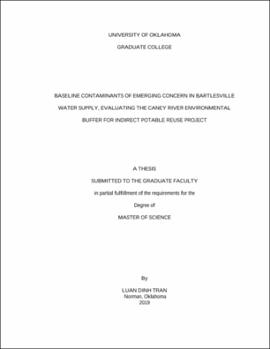| dc.description.abstract | The City of Bartlesville, Oklahoma is planning to increase their water supply through Indirect Potable Reuse (IPR), by transferring wastewater to a location about five to seven miles upstream from their water supply intake site in the Caney River. One of the many challenges is the presence of Contaminants of Emerging Concern (CEC) in the City of Bartlesville Chickasaw Wastewater Treatment Plant (CWWTP) effluent. The U.S. Environmental Protection Agency (EPA) has established Maximum Contaminant Levels (MCLs) for chemicals in drinking water supplies, but numerous CEC are unregulated because of undefined environmental toxicity or their risk to human health. Therefore, before implementing a wastewater reuse project, water suppliers must examine water quality including CEC to ensure that water delivered to the customer is reliable and safe.
In this study, we sampled six locations, including effluent, river, and lake water in Bartlesville’s water supply during three sampling events (March, July, and December 2018). Samples were analyzed for a suite of 99 CEC classified as either pesticides, industrials, Pharmaceuticals and Personal Care Products (PPCPs), hormones, or others. CEC were detected for 11 of 19 pesticides, four of six industrials, 35 of 53 PPCPs, four of eight hormones, and 10 of 13 “others” in the water samples. The sampling site near Bartlesville’s CWWTP effluent discharge contains the highest CEC concentrations and compounds in the PPCPs class were most abundant in the surface water, with a concentration of up to a few hundred nanograms per liter. Because we detected numerous CEC downstream from the effluent discharge site, we can compare effluent and downstream concentrations to compute bio-chemical half-life for these CEC. This research provides baseline data to assess the environmental risk and potential human exposure to CEC, evaluate periodic tendencies, and the effectiveness of the environmental buffer to sorb and degrade CEC through aerobic microbial reactions. The evaluation of prospective IPR scenarios indicates that a few CEC (e.g., 4-nonylphenol, Amoxicillin, Iohexol, and Sucralose) may be detectable at “Upper” trace concentrations (> 100 ng L-1) after traveling about five to seven miles from the planned upstream discharge point. However, transferring 50% of the effluent to the planned upstream discharge location would have no adverse impact on the water quality at the current water intake point in the Caney River. | en_US |
